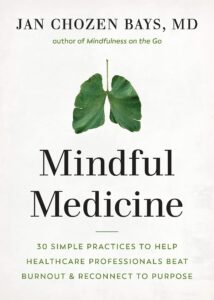Excerpts from Chozen Roshi's new book

“Why would a healthcare professional take time to practice mindfulness? Practicing mindfulness and meditation can help us become more resilient, more satisfied with our work, less likely to make errors, and make us and our patients and clients happier.
There is a growing body of research confirming the benefits of mindfulness and meditation not only for the general population but also for healthcare workers in particular. Bringing mindfulness to aspects of daily life is a vital aspect of many spiritual traditions, including the Christian, Muslim, Jewish, Hindu and Buddhist faiths. However, mindfulness can become a beneficial support to anyone’s life, secular or religious. As Dr. Jon Kabat-Zinn reminds us, isn’t it important to “show up for our life” so that we can truly experience all of our remaining days?
Often we think of meditation as an extra activity, something we have to schedule time to do in a day crammed with activities. We have to put away our laptop, pull out our meditation cushions, set a timer, turn off our telephone, and then purposely engage in an activity called “meditation.” We have to schedule time off from work to soak in the healing silence of a retreat. We have even added it to our identity: “I am a meditator.”
But over the course of human evolution, meditation was a natural part of life. People sat around fires and watched the flickering flames. We stood in streams and hid along animal trails, withdrawing our thoughts and human personalities so as not to be detected, merging our minds with the earth, wind, and the minds of our prey. We lay on hillsides at night, alert to the sounds among our flocks of sheep, watching the stars slowly spin in the dark and deep heavens above. We walked in silence for miles and our minds expanded to include the sounds and movements of our home, a change in the temperature of the wind, the sudden silence of birds in the forest and the slight movement of a lizard camouflaged in desert sand.”
This book includes many practical tools we can use in our everyday life to engage in mindfulness. Here is an example:
A Mindful Walking Path
The Practice:
“Pick a path, corridor, or walkway you routinely use. It could be a certain corridor in your workplace or the path into the building you work in. While you are walking on that path, intentionally let go of thoughts. Move your awareness to the changing sensations in the bottoms of your feet and in your legs.
Many people are introduced to mindful walking that is very slow, but you don’t need to walk like a zombie down the corridor to the conference room. Walk at a normal pace or try changing your walking speed to discover how speed affects mindfulness. You can try slow walking in a park or at home, where you have more time, space, and privacy. If you are using a wheelchair just bring full attention to the movements of you body as you travel forward.
REMINDING YOURSELF
It can be extremely easy to “go on autopilot” and forget to bring deliberate mindfulness to a familiar path. The mind tends to jump ahead to think about what will occur at the end of the path. Be creative. You could tape a bit of paper or ribbon to the toe of your shoe, where it will catch your attention or even annoy you until you remove it after you’ve walked you mindful path. I used to do mindful climbing, deliberately avoiding the elevator in order to climb the two flights of stairs from the hospital parking garage to my office each morning, with full attention in my legs, feet and breath. After a week, the sight of the stairway initiated the practice. Your mindful walking path becomes one of you “islands of pure attention” that refresh you throughout the day. “
Follow this link to the Zenworks Store to get your own copy of Chozen’s new book: Mindful Medicine: 40 Simple Practices to Help Healthcare Professionals Heal Burnout & Reconnect to Purpose.
